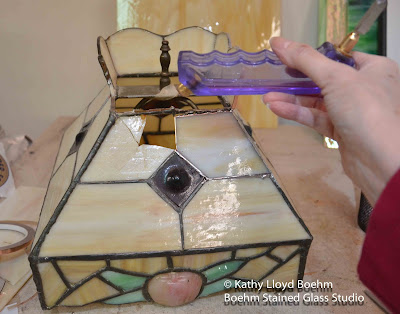This project is a great example of how I created a stained glass window from a photograph. My customer and her husband wanted a special gift for her sister's second wedding. She was engaged in Montana. My customer sent me several photographs which she "borrowed" unobtrusively from her sister's FaceBook page. All were lovely but not all were suited to be converted into stained glass. We met after I rendered them in glass, and this photograph was the winner!
Here's my computer rendition of the photograph. Note the heart in the wall. That was a nice touch, a suggestion from my customer.
Here I'm preparing the pattern. Bottom layer is manila folders, middle is carbon paper, top is the paper pattern or "cartoon". I trace all markings and colors for each piece of glass onto the folders.
The outer edge of the pattern is cut with regular scissors.
All pattern pieces are cut with double-bladed stained glass pattern shears. They leave a thin channel of paper between each piece to allow for the copper foil which will follow.
Here's a collection of thin strips cut out by the pattern shears.
Next, I group each pattern piece, by color, into recycled junk mail envelopes. I generally cut all of one color at a time.
Using an oil-filled pistol grip glass cutter to score a line onto the "cloud" glass.
Since this piece has several curves which would be too risky to cut by hand, I'm using my wet ring saw to do the job. I'm applying lip balm to the Sharpie markings to prevent the water from washing them off.
Here's how well the ring saw does on complicated curves.
Grinding the edges of the glass to make them safe to handle and to improve the adhesion of the copper foil.
Moving onto the light amber glass for the wall. I've traced several pieces onto a piece of glass.
These "groziers" nip off small piece of glass.
The "running pliers" will snap a straight score in half.
More pieces marked and ready for cutting.
The "cartoon" is push-pinned to my work surface and enclosed in a metal "fence" as shown. This keeps the glass pieces from shifting as I work.
The wall is beginning to take shape.
Sky being cut.
Using mirror glass for the river. Here I'm tapping on the glass after I scored it. Doing this repeatedly will release the glass and separate it.
Back to the saw for some intricate curves.
More pieces cut and in place on the "cartoon".
The mountains are a deep purple, as seen when held to the light.
Moving on to the light green hills on the left.
Now all the glass has been cut.
At this point, I decided that the wall needed a little something more. One of the photographs I was given featured pink flowers which were blooming in the area. After I spoke with my customer and got her approval, I modified my original rendition to include some of the flowers in the foreground. I like the added color and the foreground interest better now.
Close-up of the flowers.
Etching my name and date of presentation (June 2017) into the lower right corner.
The start of the copper foil process. Each piece gets foiled at the edge.
The top part of the window has been foiled. During this process, the glass will "grow" a bit. Notice the silver dots at the edge of the large piece below. These edges fit a bit too tightly. Therefore I brought it back to the grinder to wear down those areas for a better fit. As the foiling continues, these tweaks are often needed.
Placing a foiled piece onto the pattern. Notice how the river is reflective. I used mirror glass for that effect.
Now the piece is foiled except for the wall, which I'm going to modify by adding flowers.
Using my computer rendition as a general guide, I drew over the wall to indicate where to cut out small areas for the addition of the pink flowers.
Now the areas are cut out.
Tracing the new pieces onto the pink glass.
Now the pink flowers are in place and the entire window has been foiled.
Here I'm reinforcing the window by adding random lengths of braided copper reinforcement wire throughout. These fit between the pieces of glass and become invisible after soldering.
Applying liquid flux to the copper foil. This acts as a catalyst to enable the solder to flow freely onto the foil.
Tack soldering process. Here I'm applying small beads of solder randomly to the intersections of the glass to lock them in place.
After its been tack soldered, I remove the fence and slide out the cartoon.
The window, fully soldered on the front.
Next, my husband Eric makes a custom sized zinc metal frame for the window.
Fitting the window in place.
Soldering the frame onto the window.
Soldering the hooks onto the upper corners.
Applying patina to turn the solder black.
Cleaning the entire piece with Kwik-Clean which removes all traces of flux and patina. The window is actually cleaned several times throughout the process. After this final cleaning, the window is left to dry. Then I apply stained glass finishing compound to add shine to the glass and to protect the patina.
And here its complete!
Another view, taken outdoors. Now the sky is more visible.
Thank you Robyn and Rodger for bringing me in to create this personalized and very special wedding gift! It was a pleasure meeting you both!
For more information on my other projects,
please click here to visit my website.



















































































